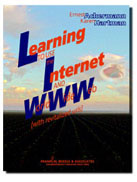| Summary Terms Exercises |
|
Chapter 6 |
|
|---|---|
Supplemental Material (available on CD with book)
- "Configuring Outlook Express for Email and Usenet News" Detailed instructions for setting up Outlook Express (PDF)
- "Using Outlook Express" Details about using Outlook Express for email
- "Configuring Netscape Messenger for Email and Usenet News" Detailed instructions for setting up Netscape Messenger (PDF)
- "Using Netscape Messenger" Details about using Netscape
Messenger, the email system that comes with Netscape Communicator
- URLs from the chapter (HTML)
- Copies of the review questions in quiz format (PDF)
Electronic mail allows Internet users to communicate with each other electronically. Using the email program with Netscape Communicator, you can compose messages and then send them to any other Internet address. You can read the messages you've received, save them to a file, print them, or delete them. You also can reply to a message or forward one to another Internet address. There are several other email clients available and other ways to work with email on the Internet.
An email message consists of three main parts: the header, which contains information about the address of the sender, the address of the recipient, when the message was sent, and other items; the message body, which holds the text portion of the email; and an optional signature, which holds information about the sender such as full name, mailing address, phone number, etc. The signature, which should be limited to four or five lines, is put into a file that can be automatically included with each message.
To send email, you must give the Internet address of the recipient, compose or write the message, and then give a command to send it on its way. The message is broken up into packets, each containing the address of the sender and the address of the recipient, and the packets are routed through several sites on the Internet to the destination. The computer systems on the Internet handle the transmission and delivery of the email. Once email arrives at a site, it's put into a system mailbox for an individual user. The user can read the email on the system by using an email program like the one available with Microsoft Outlook Express.
Email is a convenient and efficient means of communication. However, most communication is done by the text of messages, so you have to be considerate and careful to communicate effectively, without misunderstandings. Because you probably have a limited amount of space on your computer for email, be sure to get rid of unwanted or unnecessary email and also be sure to send concise, appropriate messages to others. Email isn't necessarily private. Because it's transmitted electronically, opportunities for someone else to read your messages do exist. It's relatively easy to forward copies of email so a message sent to one person can be easily transmitted to others.
Email or Internet addresses usually have the form of local-name@domain-name. Local-name is often the login or user name of the person receiving the email, and domain-name is the Internet name of the site or computer system receiving the messages. It's possible to send email to addresses on networks that are not on the Internet. You need to know the proper form of an address to communicate with users on these networks.
Finding someone's email address isn't always easy. There is no central
directory keeping a list of email addresses for everyone on the Internet.
If you want to find someone's address, one of the best things to do is
to call or write that person and ask for the email address. In addition,
a number of automated services can help you search for an email address.
Terms
Exercises
Available on Cd with book.
This material has been prepared to accompany the book "Learning to Use the Internet and the World Wide Web" (ISBN 1-887902-78-3) by Ernest Ackermann and Karen Hartman, and published by Franklin, Beedle and Associates, Incorporated, Wilsonville, OR. © 2002. No part of this may be reproduced, stored in a retrieval system, or transcribed without permission of the publisher.
| You can help support this site by buying books, CDs, and other items after clicking on this link. |  |
Number of visits here since May 10, 2002.
